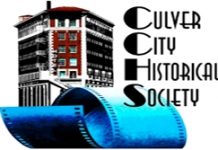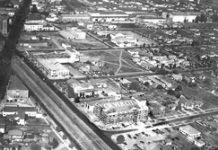History is like a puzzle, put together with great stories—just one way your historical society preserves our local history.
The society recently featured one of our “favorite sons” in the CCHS Archives for a taping of some of his Culver City memories and his professional perspective on local Native Americans.
Charles Rozaire came to Culver City with his parents as a young child. He attended Culver Grammar School with classmates like Virgie (Tinger) Eskridge.
Since he lived on the east side of Sepulveda, he attended Hamilton High School. Charles continued his education at UCLA, and became a noted anthropologist and archeologist.
Dr. Rozaire served as the curator for the Southwest Museum, Curator of Archeology for the Los Angeles County Museum of Natural History, taught courses at UCLA, and participated in fieldwork across the continent.
Dr. Rozaire remains a Southern California resident and we enjoy his presence occasionally at historical society events. But this was special.
Virgie and Charles sat and chatted as if time stood still—they talked about their neighborhoods and growing up in the Heart of Screenland.
Charles and his parents lived next door to a councilmember, Bill Douglas, for example, and up the street from Mike and Mabel Tellefson. (Tellefson served as CAO, City Attorney and Mayor.)
He recalled a “whistle” blowing at 8AM each morning as he walked to school. It came from the studio, now known as The Culver Studios.
Charles scoffed at some of the students waiting for stars autographs at MGM’s East Gate—until Virgie told him the price for which one of their friends sold her autograph book. He shared stories of being a student at UCLA, including frustration with PE classes.
He reminded us the local Indians were known hunters and gatherers—and their Uto-Aztecan linguistic style was like a wedge between the Chumash natives north and south of us.
The setting was the Archives and Resource Center, with artwork behind depicting the lifestyle of the local natives Americans, known as Gabrielinos.
In cases beyond, were copies of disenos (maps) of the two Ranchos from which Culver City was carved (La Ballona and Rincon de los Bueyes), the story of the early families, like Machados and Talamantes. From a buggy whip to a cattle brand issued by the state in 1887 to a ranchera, and for balance—the ornate comb she wore in her hair.
Costumes, one a new acquisition from “The Merry Widow,” worn by another “home-grown,” Gwen Verdon is on display. Nearby, a page from Harry Culver’s book of cross-country travels in 1929 as the head of the National Real Estate Association stands out.
From the MGM Costumes collection, a summer exhibit, featuring Esther Williams’ bodysuit worn in “Neptune’s Daughter, ” a display going back to the original 1951 Fiesta, and on loan from Pat Clapp, a sample of LA 84 Olympics memorabilia.
The taping by society photographer Kevin Lachoff was another free event, open to the public, and it is now a part of the society’s oral history program. The Culver City Historical Society is a non-profit charitable organization.













